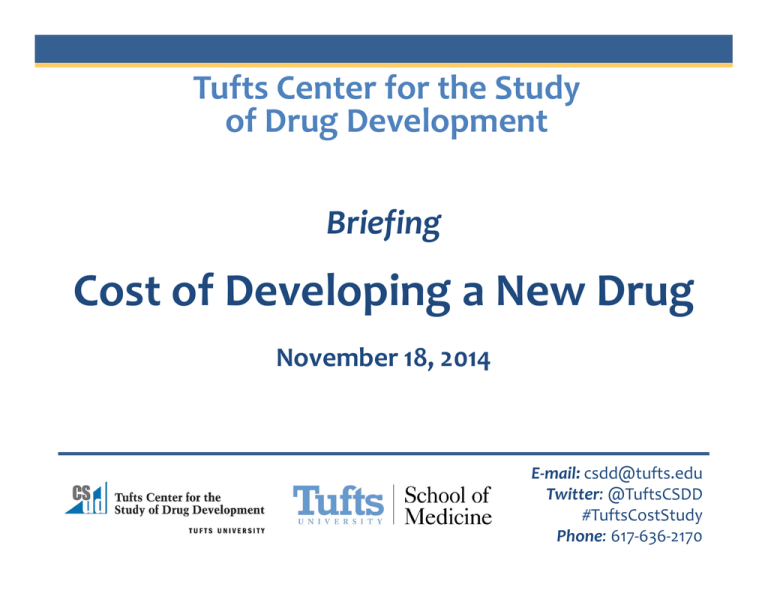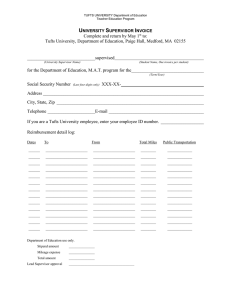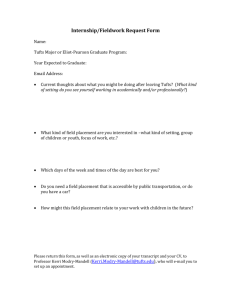
Tufts Center for the Study
of Drug Development
Briefing
Cost of Developing a New Drug
November 18, 2014
E-mail: csdd@tufts.edu
Twitter: @TuftsCSDD
#TuftsCostStudy
Phone: 617-636-2170
Innovation in the
Pharmaceutical Industry:
New Estimates of R&D Costs
Joseph A. DiMasi, Ph.D.
Director of Economic Analysis,
Tufts Center for the Study of Drug Development
R&D Cost Study Briefing
Boston, MA, November 18, 2014
Study Coauthors
Henry G. Grabowski, Ph.D.
Professor Emeritus, Department of Economics
Director, Program on Pharmaceutical and Health Economics
Duke University
Ronald W. Hansen, Ph.D.
William H. Meckling Professor of Business Administration
Senior Associate Dean for Program Development
Simon Business School
University of Rochester
Agenda
• Main Finding
• Data and Methods
• Clinical approval rates, phase transition rates, and out-ofpocket costs per approved compound
• Development times, the discount rate, and capitalized costs
per approved compound
• Post-approval cost estimates
• R&D cost growth rates
• Cost drivers
Main Finding:
The estimated average pre-tax
industry cost per new prescription
drug approval (inclusive of failures
and capital costs) is:
$2,558 million
COPYRIGHT PROTECTED
New Drug and Biologics Approvals and R&D Spending
R&D Expenditures
New Compound
Approvals
R&D expenditures are adjusted for inflation; curve is a 3-year moving average for NME/NBEs
Sources: Tufts CSDD; PhRMA, 2014 Industry Profile
© 2014 Tufts University. All rights reserved. May not be reproduced, transmitted, or
distributed by any means, mechanical or electronic, in whole or in part, without
written permission from the Tufts Center for the Study of Drug Development.
Data and Methods
Outline of Study Cost Dataset
• 106 investigational new drugs and biologics from 10 firms first tested in
humans anywhere in the world, 1995-2007
• Clinical period development cost data up to 2013
• Five compounds still active at the time of data collection.
• Compounds that lasted late in development oversampled to increase
the amount of information for late development stages. Results then
weighted to reflect the population distribution.
• Annual company biopharmaceutical R&D expenditures from 1990 to
2010 broken down in various ways (used to estimate pre-human R&D
costs).
Elements Used to Determine Fully Allocated
New Compound R&D Costs
• Out-of-pocket clinical costs (all indications, long-term
animal testing, overhead, CMC during clinical testing and
prior to first approval)
• Out-of-pocket discovery research and preclinical
development costs
• Clinical approval success and phase attrition rates
• Development times
• Cost of capital
Out-of-Pocket Clinical Costs
• Survey data on costs by phase and year for a sample of
investigational compounds.
• Oversampled compounds that proceeded to late-stage testing:
stratified random sample.
• Weight survey response to reflect actual population distribution
for strata.
• Calculate weighted average phase costs.
Out-of-Pocket Discovery and Preclinical
Development Costs
• Cannot attribute all pre-human R&D costs to specific
compounds.
• Use time series data on company annual aggregate spending
on pre-human and clinical R&D.
• Apply lag structure on data based on gap between pre-human
and clinical expenditures (difference in median phase times).
• Determine ratio of pre-human to clinical expenditures from
lagged data.
• Apply ratio to clinical phase cost estimate to obtain a prehuman cost estimate.
Clinical Approval Success Rates
• Since many compounds fail in testing, phase costs must be
weighted by the probability of entering the phase (expected
costs) to obtain costs per investigational compound.
• Overall clinical approval success rates used to translate cost
per investigational compound to cost per approved compound.
• Tufts CSDD database of investigational compounds used to
estimate these probabilities (subset relevant to cost study
sample period).
• Other interesting results obtained: attrition rates and distribution
of failures by phase.
Phase Development Times
• Use survey data to find average time in phase (across
indications).
• Use survey data to find average time between start of one
phase and beginning of the next phase.
• Average phase-to-phase times used to establish a
representative development time profile from synthesis to
approval.
• Representative time profile, along with average phase lengths,
used to determine how expenditures are distributed over time.
Cost of Capital and Capitalization
• Cost of capital is the expected return required by investors to
get them to invest in drug development.
• Capital Asset Pricing Model (CAPM) applied to data on
biopharmaceutical firms over relevant period to determine an
industry cost of capital.
• Estimate is based on data on stock market returns and debtequity ratios for a sample of biopharmaceutical firms.
• Used as the discount (interest) rate to capitalize R&D
expenditures to marketing approval according to the
estimated development timeline.
Results
Data for Phase Transition and Approval
Success Rate Estimates
• Dataset of investigational compounds in the portfolios of top 50
firms (several commercial pipeline databases, published
company pipelines, clinicaltrials.gov, web searches).
• Subset of self-originated compounds first tested in humans
anywhere in the world from 1995 to 2007.
• 1,442 compounds met study inclusion criteria.
• Development status checked through end of 2013.
• For this set of compounds, 7.1% were approved, 80.3% had
been discontinued in some phase, and 12.6% were still active in
some phase.
COPYRIGHT PROTECTED
Transition Probability
Clinical Phase Transition Probabilities and Overall
Clinical Approval Success Rate*
90.35%
61.95%
59.52%
35.52%
11.83%
Phase I-II
Phase II-III
Phase III-NDA/BLA Sub
NDA/BLA SubNDA/BLA App
*Therapeutic new molecular entities and new therapeutically significant biologic
entities first tested in humans, 1995-2007
© 2014 Tufts University. All rights reserved. May not be reproduced, transmitted, or
distributed by any means, mechanical or electronic, in whole or in part, without
written permission from the Tufts Center for the Study of Drug Development.
Phase I - NDA/BLA
App
COPYRIGHT PROTECTED
Representative Development and Regulatory Review
Time Profile (synthesis to approval)
Synthesis ─ Approval
128.0
Clinical Start ─ Approval
96.8
Synthesis ─ Phase I
Phase I ─ II
31.2
19.8
Phase II ─ III
30.3
Phase III ─ NDA/BLA Submission
30.7
NDA/BLA Submission ─ Approval
16.0
Months
© 2014 Tufts University. All rights reserved. May not be reproduced, transmitted, or
distributed by any means, mechanical or electronic, in whole or in part, without
written permission from the Tufts Center for the Study of Drug Development.
Pre-human Cost Estimates
• Annual data on pre-human and clinical period company R&D
expenditures on self-originated investigational compounds aggregated
across companies.
• Need to impose a lag structure between pre-human and clinical
expenditures.
• Based on development time data, we used a 5-year lag between
median pre-human and median clinical expenditures .
• Implies that pre-human expenditures are 30.8% of costs per approved
compound.
• Results are not very sensitive to assumed lag within reason (4 and 6year lags applied in sensitivity analysis)
COPYRIGHT PROTECTED
Nominal and Real Cost of Capital (COC) for the
Biopharmaceutical Industry, 1994-2010
1994
2000
2005
2010
Nominal COC
14.2%
14.9%
13.3%
11.4%
Inflation Rate
3.1%
3.1%
2.5%
2.0%
Real COC
11.1%
11.8%
10.8%
9.4%
Implication: R&D costs were capitalized at a 10.5% real COC
© 2014 Tufts University. All rights reserved. May not be reproduced, transmitted, or
distributed by any means, mechanical or electronic, in whole or in part, without
written permission from the Tufts Center for the Study of Drug Development.
COPYRIGHT PROTECTED
Out-of-Pocket and Capitalized Cost per Approved New
Compound
Millions of 2013 $
2,558
1,460
1,098
1,395
965
430
Pre-human
Clinical
Out-of-Pocket
Total
Capitalized
© 2014 Tufts University. All rights reserved. May not be reproduced, transmitted, or
distributed by any means, mechanical or electronic, in whole or in part, without
written permission from the Tufts Center for the Study of Drug Development.
COPYRIGHT PROTECTED
Pre-approval, Post-approval and Total Lifecycle Cost
per Approved New Compound
Millions of 2013 $
2,870
2,558
1,861
1,395
466
Out-of-Pocket
Total
312
Capitalized
Pre-approval
Post-approval
© 2014 Tufts University. All rights reserved. May not be reproduced, transmitted, or
distributed by any means, mechanical or electronic, in whole or in part, without
written permission from the Tufts Center for the Study of Drug Development.
COPYRIGHT PROTECTED
Millions of 2013 $
Growth in Capitalized R&D Costs
per Approved New Compound
2,558
1,460
1,098
1,044
608
109
278
436
70
Pre-human
1970s
135
Clinical
1980s
1990s-early 2000s
413
179
Total
2000s-early 2010s
Sources: 1970s, Hansen (1979); 1980s, DiMasi et al. (1991); 1990s-early 2000s, DiMasi et
al. (2003); 2000s-early 2010s, Current Study
© 2014 Tufts University. All rights reserved. May not be reproduced, transmitted, or
distributed by any means, mechanical or electronic, in whole or in part, without
written permission from the Tufts Center for the Study of Drug Development.
COPYRIGHT PROTECTED
Compound Annual Inflation-Adjusted Growth Rates
for Out-of-Pocket R&D Costs
11.8%
9.6%
9.2%
7.8%
9.3%
7.0%
6.1%
7.6%
2.3%
Pre-human
1970s to 1980s
Clinical
1980s to 1990s
Total
1990s to early 2010s
© 2014 Tufts University. All rights reserved. May not be reproduced, transmitted, or
distributed by any means, mechanical or electronic, in whole or in part, without
written permission from the Tufts Center for the Study of Drug Development.
COPYRIGHT PROTECTED
Compound Annual Inflation-Adjusted Growth Rates
for Capitalized R&D Costs
12.2%
10.6%
9.4%
8.8%
7.4%
7.3%
8.5%
7.4%
3.5%
Pre-human
1970s to 1980s
Clinical
1980s to 1990s
Total
1990s to early 2010s
© 2014 Tufts University. All rights reserved. May not be reproduced, transmitted, or
distributed by any means, mechanical or electronic, in whole or in part, without
written permission from the Tufts Center for the Study of Drug Development.
COPYRIGHT PROTECTED
Cost Drivers: Change in Capitalized Cost per
Approved Compound by Factor (direct cash outlays)*
Factor Category
Cash Outlays
Factor
Percentage Change
in Cost
Out-of-Pocket Clinical Phase Costs
82.5%
Pre-human/Clinical Cost Ratio
1.6%
Overall Out-of-Pocket Costs
85.5%
* Factor impact on current study cost relative to prior study cost ($1,044 million in 2013 dollars)
© 2014 Tufts University. All rights reserved. May not be reproduced, transmitted, or
distributed by any means, mechanical or electronic, in whole or in part, without
written permission from the Tufts Center for the Study of Drug Development.
COPYRIGHT PROTECTED
Cost Drivers: Change in Capitalized Cost per
Approved Compound by Factor (development risk)*
Factor
Category
Risk
Factor
Percentage
Change in Cost
Clinical Approval Success Rate with Prior Study
Distribution of Failures
57.3%
Distribution of Failures with Prior Study Clinical
Approval Success Rate
-6.0%
Overall Risk Profile: Clinical Approval Success
Rate plus Distribution of Failures
47.3%
* Factor impact on current study cost relative to prior study cost ($1,044 million in 2013 dollars)
© 2014 Tufts University. All rights reserved. May not be reproduced, transmitted, or
distributed by any means, mechanical or electronic, in whole or in part, without
written permission from the Tufts Center for the Study of Drug Development.
COPYRIGHT PROTECTED
Cost Drivers: Change in Capitalized Cost per
Approved Compound by Factor (time and cost of capital)*
Factor Category
Time
Cost of Capital
Factor
Percentage Change in
Cost
Pre-human Phase
-4.9%
Clinical Phase
0.2%
Regulatory Review
-3.0%
Overall Development Timeline
-5.6%
Discount Rate
-3.1%
* Factor impact on current study cost relative to prior study cost ($1,044 million in 2013 dollars)
© 2014 Tufts University. All rights reserved. May not be reproduced, transmitted, or
distributed by any means, mechanical or electronic, in whole or in part, without
written permission from the Tufts Center for the Study of Drug Development.
Summary
• Total capitalized cost per approved new compound grew at an
8.5% compound annual rate; out-of-pocket cost per approved
new compound grew at a 9.3% annual rate.
• Clinical approval success rates have declined significantly.
• Increases in the cash outlays used to conduct clinical
development and higher drug failure rates during clinical testing
have contributed most to the estimated increase in R&D costs.
• Changes in the time to develop and get new drugs approved
and in the cost of capital had modest moderating effects on the
increase in total R&D cost.
Tufts Center for the Study
of Drug Development
Tufts University, Boston, Massachusetts, USA
Joseph A. DiMasi, Ph.D.
Director of Economic Analysis
Website
http://csdd.tufts.edu
Email
joseph.dimasi@tufts.edu




